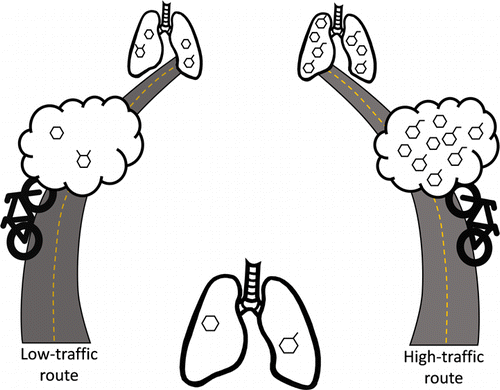Measuring the airborne toxicants urban bicyclists inhale

By switching from four wheels to two, bicyclists help reduce traffic and air pollution—all while getting much-needed exercise. But that health benefit could be costly, due to exposure to potentially harmful compounds in motor vehicle exhaust. In a first-of-its-kind study, researchers analyzed breath samples to find out how much of these compounds are absorbed by the body. They report their findings in ACS' Environmental Science & Technology.
Previous reports have suggested that cycling in more rural areas and on off-street paths can reduce exposure to traffic-related toxicants. Absorption of compounds in the body—which can lead to deleterious health effects—is not always directly proportional to exposure, say this study's researchers. It is a complex analysis because pollution levels and the way the human body processes compounds can vary. A few teams have investigated this for bicyclists, and they focused on the analysis of blood, urine and saliva samples from those riding in urban or rural areas. But until now, no one has looked at bicyclists' absorption of pollutants while riding on multiple types of routes. So, Alexander Bigazzi and colleagues took a more in-depth look at the issue by using breath analysis.
The researchers studied the breath of three cyclists in Portland, Oregon, who rode on off-street bike paths, local streets with lighter traffic and main streets with heavier traffic. They also measured pollution levels in ambient air. Using a pollution detector mounted on the bicycles, the team found that the on-road exposure levels (above the urban background) of volatile organic compounds, a kind of pollution, were 100 to 200 percent higher when the cyclists took routes through high-traffic or industrial areas as compared to low-traffic or off-street routes. Using breath analysis, the team found that absorbed compounds were 40 to 100 percent higher in these situations. The study confirms that people can reduce their exposure and absorption of these toxicants - and potentially mitigate their health effects—by riding farther away from city traffic.
More information: Alexander Y. Bigazzi et al. Breath Biomarkers to Measure Uptake of Volatile Organic Compounds by Bicyclists, Environmental Science & Technology (2016). DOI: 10.1021/acs.est.6b01159
Abstract
Breath biomarkers were used to study uptake of traffic-related volatile organic compounds (VOCs) from urban bicycling. Breath analysis was selected because it is one of the least invasive methods to assess urban traveler exposure. Research hurdles that were overcome included considering that factors other than on-road exposure can influence concentrations in the body, and absorbed doses during a trip can be small compared to baseline body burdens. Pre-trip, on-road, and post-trip breath concentrations and ambient air concentrations were determined for 26 VOCs for bicyclists traveling on different path types. Statistical analyses of the concentration data identified eight monoaromatic hydrocarbons potentially useful as breath biomarkers to compare differences in body levels brought about by urban travel choices. Breath concentrations of the biomarker compounds were significantly higher than background levels after riding on high-traffic arterial streets and on a path through a high-exposure industrial area, but not after riding on low-traffic local streets or on other off-street paths. Modeled effects of high-traffic streets on ambient concentrations were 100–200% larger than those of low-traffic streets; modeled effects of high-traffic streets on breath concentrations were 40–100% larger than those of low-traffic streets. Similar percentage increases in breath concentrations are expected for bicyclists in other cities.
Journal information: Environmental Science & Technology
Provided by American Chemical Society



















